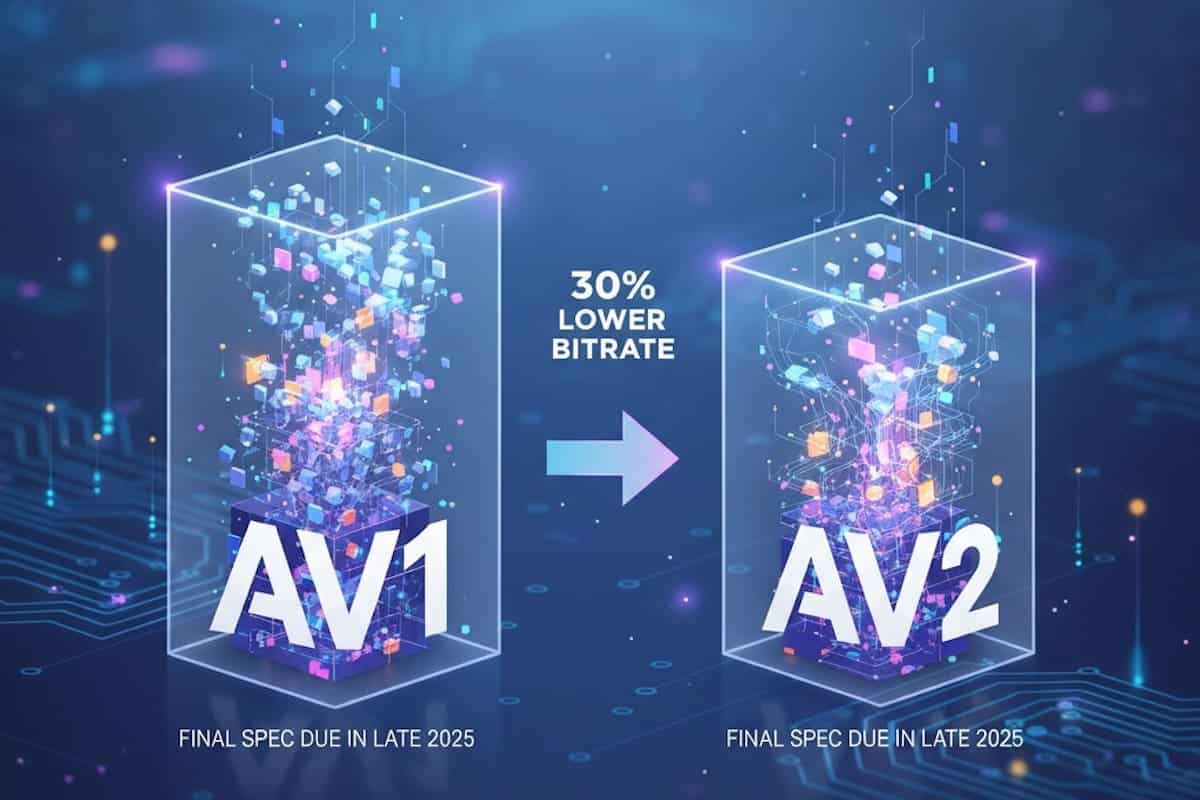Video compression is on the move again. The Alliance for Open Media (AOMedia) is approaching the final stretch of AV2, their upcoming open-source, royalty-free codec, with a compelling promise: about 30% bitrate reduction for the same visual quality compared to AV1. Supported by internal testing from the working group, this figure directly impacts the economics of streaming, on-demand video, cloud gaming, and any service that needs to move pixels efficiently across the internet.
After five years of development, the core tools of the codec are finalized, and the high-level syntax is in advanced stages. The schedule outlined by the alliance indicates the final specification by late 2025. If on track, this milestone will trigger the next phase: encoder optimization, software adoption, and crucially, silicon integration for hardware decoding (and later encoding).
What really changes with AV2
AV2 isn’t a departure from the past but an evolution of the hybrid block-based approach dominating modern compression. It maintains AV1’s familiar structure but introduces significant improvements across nearly all pipeline stages:
- Larger blocks and more flexible partitioning. Transitioning to superblocks of 256×256 enables capturing large-scale patterns with less overhead. The recursion-based partitioning — fully flexible — fine-tunes adjustments to textures, edges, and motion regions, avoiding waste of bits where they’re unnecessary.
- Smarter intra prediction. Incorporating data-driven modes that leverage statistical content analysis to choose directions and patterns. Reinforcing chroma-from-luma (CFL) allows luminance information to help predict chroma without sacrificing detail.
- Inter prediction with better-managed memory. AV2 hierarchizes references and enables selection of up to seven past frames using a ranking system that makes more informed choices. The highlight innovation is Temporal Interpolation Prediction (TIP), a method that interpolates temporal information to improve motion handling in high-resolution scenes or fast-changing content.
- Quantization with more control. Introduction of a unified exponential quantizer with a broader range for 8, 10, and 12 bits, complemented by trellis-coded quantization (TCQ) and user-defined matrices. The goal: preserve microdetails at aggressive bitrates and provide refined controls to tailor quality degradation as desired.
- Transformations that preserve textures. The codec adds “learned” transforms and cross-component transforms to better capture correlations with fewer artifacts, especially crucial for skin, foliage, grain, and fine patterns. Concurrently, coefficient encoding is refined for better handling of screen content and mixed materials (UI, presentations, animated graphics).
- Post-processing for cleaner images without “washing out”. A generalized deblocking filter replaces rigid chains, helping maintain contours and sharpness. New filters — Guided Detail Filter and Cross-Component Sample Offset — reduce compression noise with less watercolor effect. Additionally, film grain synthesis becomes more flexible to preserve cinematic look without excessive bitrate increase.
All these features are designed with an explicit requirement: hardware feasibility. The lesson learned from AV1 is clear: no matter how efficient a codec on paper, widespread adoption happens when SoCs, TVs, set-top boxes, and GPUs include dedicated, low-power, high-speed decoders. AV2 starts with that premise built into its architecture.
Why a 30% bit reduction is bigger than a headline
In a global service, saving 30% of bitrate at the same quality isn’t trivial; it’s a matter of capex and opex. Fewer bits mean:
- Cheaper CDN traffic, or, with the same budget, more concurrent sessions.
- More stored content per title and bitrate ladder, with a cumulative impact on massive VOD libraries.
- Effective quality gain in mobile networks and congested scenarios: with the same bandwidth, less buffering and less degradation.
For creators and broadcasters, this efficiency can recalibrate the balance between quality and cost: more stable 1080p60, accessible 1440p in more regions, 4K HDR with less penalty, and better texture preservation in complex shots. In cloud gaming and interactive video, where latency and fine details matter, these new predictions and filters promise fewer artifacts at aggressive bitrates.
A phased rollout: software today, hardware tomorrow
The real adoption of a codec isn’t decided on the day the specification is finalized. It happens in three overlapping phases:
- Software. Reference libraries and optimized encoders/decoders (e.g., “SVT” branches or AOM implementations), integration into transcoding toolchains, plugins for NLEs, and browser support. This phase enables testing and controlled deployments but involves high computational costs, especially during encoding.
- Hardware (decode). When dedicated decoding hardware arrives in mobiles, TVs, and STBs, it unlocks mass user experience: longer battery life, less heat, seamless zapping, and stability. This is usually the turning point for widespread adoption.
- Hardware (encode). Encoding acceleration comes later and is critical for large-scale live events and workflows with tight SLAs. Until then, live production will likely rely on previous codecs (HEVC/AV1), while AV2 gains ground first in VOD and catalogs.
Where AV2 sets the bar compared to HEVC, VVC, and AV1
The current ecosystem features several generations: HEVC (H.265) remains prevalent in broadcast, Blu-ray, and many production pipelines; VVC (H.266) offers efficiency improvements over HEVC and AV1 but carries baggage of royalties and complexity; AV1 has established itself as the dominant open codec in browsers, apps, and recent devices. If AV2 achieves approximately 30% better compression over AV1, the open ecosystem will regain competitive footing, reducing incentives to move toward fragmented licensing options.
This does not mean standards like VVC lose relevance; each vertical optimizes under its constraints (pixel quality, latency, compatibility, licensing, patents, hardware). But for internet-scale applications where cost per bit defines margins, AV2 emerges as a logical successor to AV1.
Use cases where AV2 could shine
- Global streaming of series and film. Libraries heavily featuring 4K, HDR, and cinematic grain will benefit from new quantization, transform, and grain flexibility.
- Live sports and events. Improved motion prediction with TIP and enhanced temporal efficiency are promising for demanding live content (provided encoding is sufficiently optimized).
- Screen content, education, and productivity. Finer encoding of mixed materials (UI + video) reduces artifacts in screencasts, courses, and video calls.
- Interactive video and cloud gaming. Less bits at equal quality mean better latency under same network constraints and improved detail in complex textures.
What still needs to be addressed
- Encoding speed. Next-gen codecs are resource-intensive in CPU/GPU. Aggressive optimizations and balanced presets are needed to get quality/processing time ratios suitable for VOD and especially live.
- Tools ecosystem. Integration into FFmpeg, GStreamer, professional editors, and pipelines; clear profiles and levels; reference matrices and presets per use case.
- Hardware availability. Without hardware decoding in major SoCs and TVs, mass adoption slows. The roadmaps of manufacturers will be the key indicator across 2026–2027.
- Independent testing and blind assessments. Beyond VMAF or PSNR, need viewing panels and realistic benchmarks (sports, animation, grain, mixed displays) for real-world validation of improvements.
What the industry should focus on now
- Migration planning. Identify titles or channels where 30% savings generates the highest ROI. Starting with long-tail catalogs or high-traffic titles can accelerate payback.
- Controlled pilots. Deploy A/B tests with AV2 on VOD workflows and audience segments with capable devices, measuring QoE, rebuffering, and viewing time.
- Silicon monitoring. Keep a close eye on announcements of AV2 decoding hardware for mobiles, TVs, and STBs, and adapt app and player roadmaps accordingly.
- Technical training. Prepare video and infrastructure teams to handle new tools (matrices, TCQ, TIP, filters) to maximize gains without surprises.
Looking ahead to 2026: a plausible scenario
If the specification completes by late 2025 and the ecosystem responds, 2026 could see early waves of adoption in VOD and browser-based applications where software alone is sufficient in high-end devices. The massive leap will depend on hardware support: once decoders start appearing in mid-range mobiles and TVs, and browsers enable efficient paths, penetration could mirror—and potentially surpass—the trajectory followed by AV1.
The shared goal among platforms, manufacturers, and users is straightforward but challenging: more quality with fewer bits, in an open and sustainable manner. AV2 stands as the next step towards achieving that.
Frequently Asked Questions (FAQ)
When will the AV2 specification be ready?
AOMedia expects to finalize the specification by late 2025. After that, the race will begin to optimize encoders, update toolchains, and prepare hardware support.
How much does AV2 improve over AV1?
Tests from the working group indicate about a 30% reduction in bitrate at comparable quality, with improvements seen in both PSNR-YUV and VMAF. The precise gain depends on content type, encoder preset, and network conditions.
Will new devices be needed?
For an optimal and efficient experience, yes — dedicated hardware decoding in mobiles, TVs, and future generation set-top boxes will be necessary. Meanwhile, software decoding remains feasible on high-end devices but with higher power consumption and possible limitations in low-battery scenarios.
Which use cases will see early improvements?
VOD and catalogs with high proportions of 4K/HDR and cinematic grain will benefit soonest. Live and sports content improvements depend on encoder optimization and hardware decoding support. Screen content (education, productivity) will also experience fewer artifacts at lower bitrates.
Sources
- Alliance for Open Media (AOMedia) — “AV2 Video Codec Architecture”, technical presentation by Andrey Norkin (Netflix).
- Public communications from AOMedia about AV2’s schedule and technical coverage.
- Sectorial info on efficiency comparison and adoption status of AV1/HEVC/VVC across platforms and devices.
- Internet Útil


